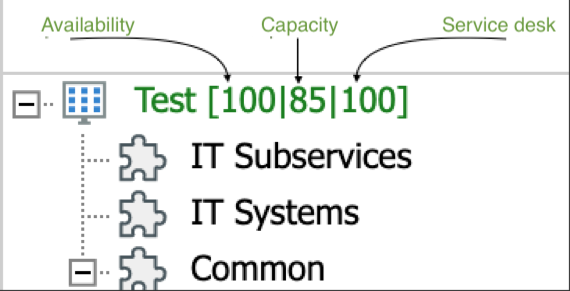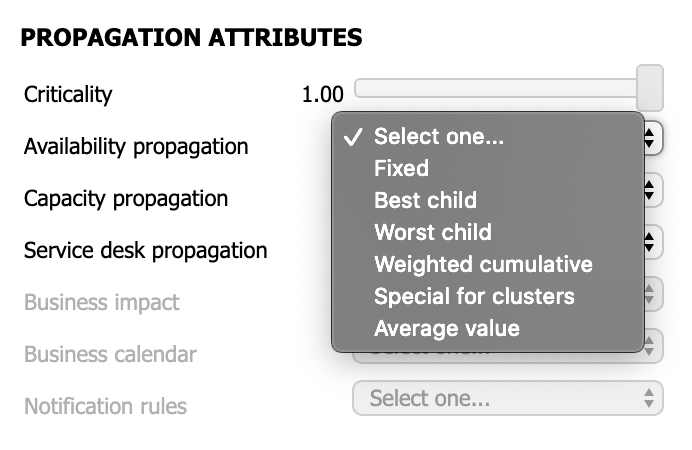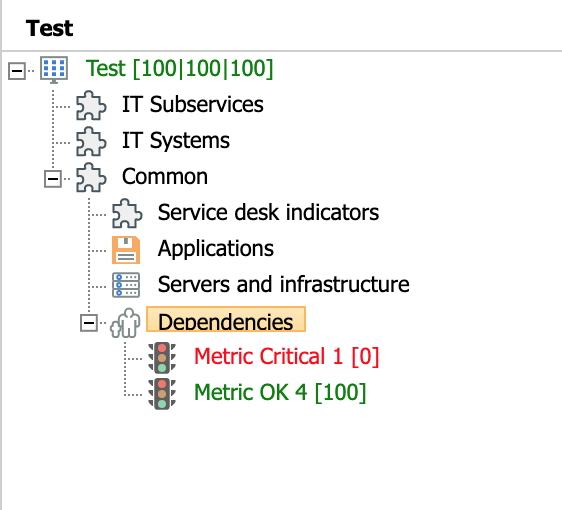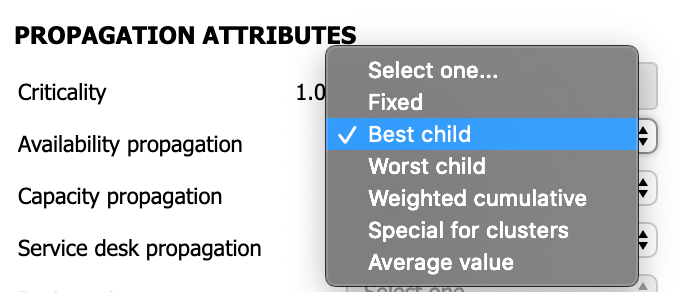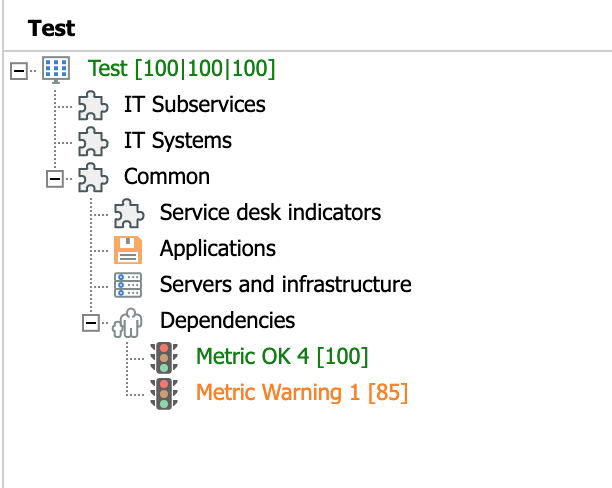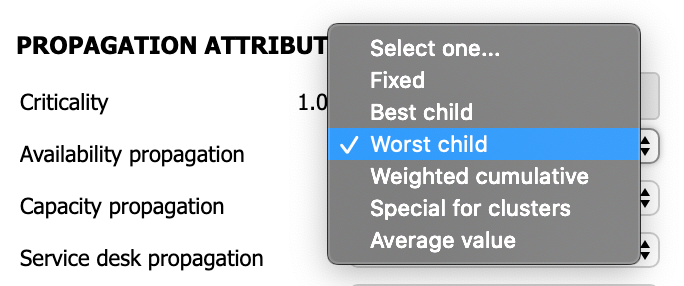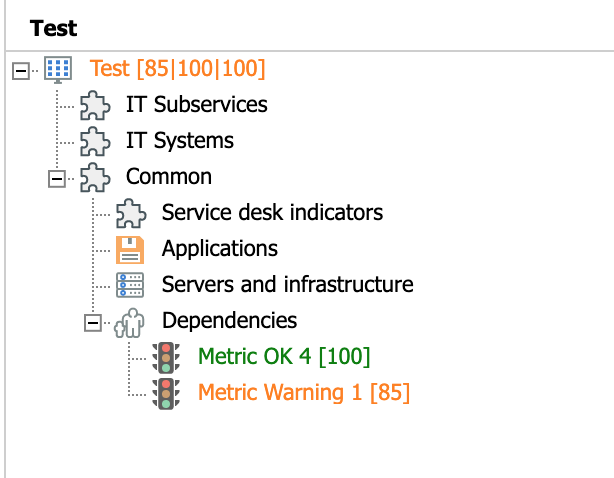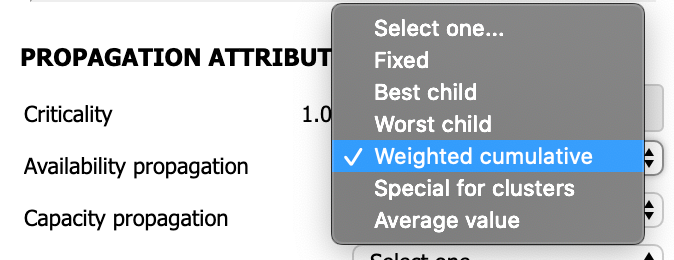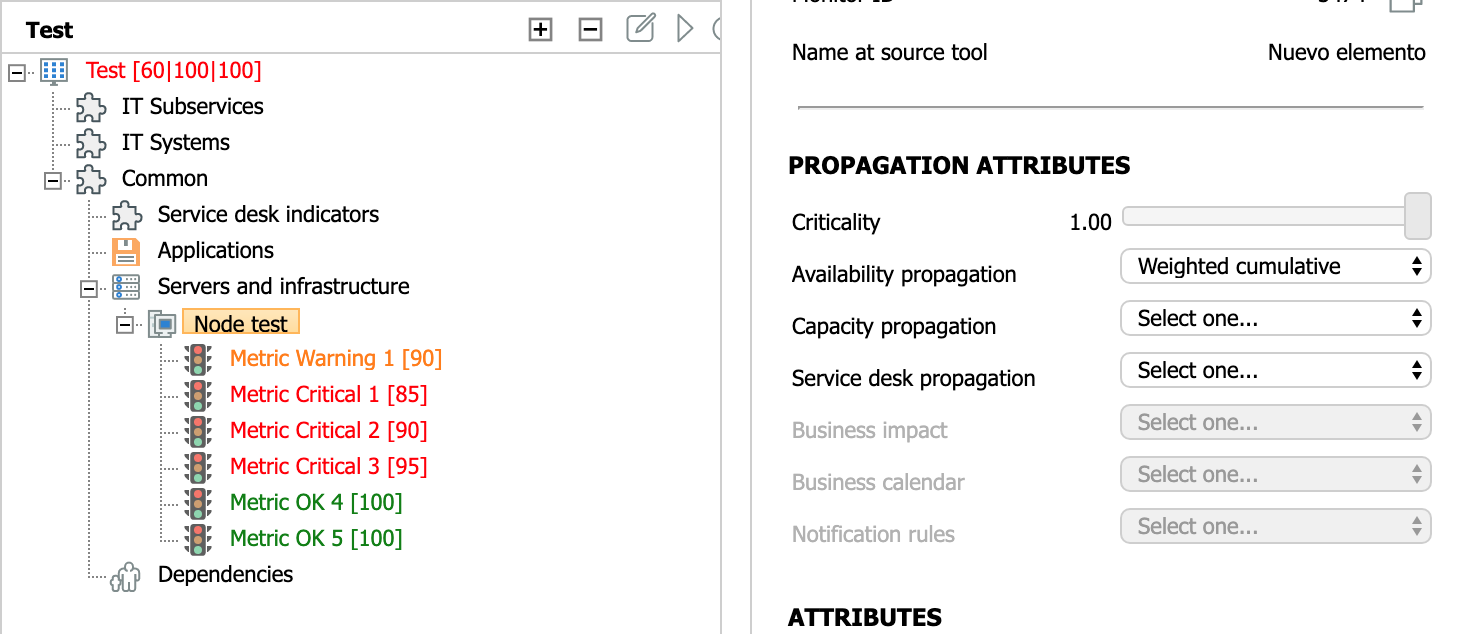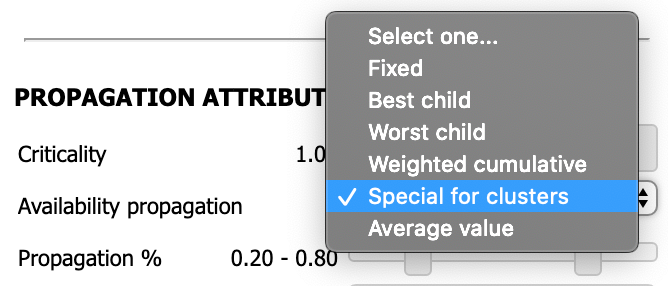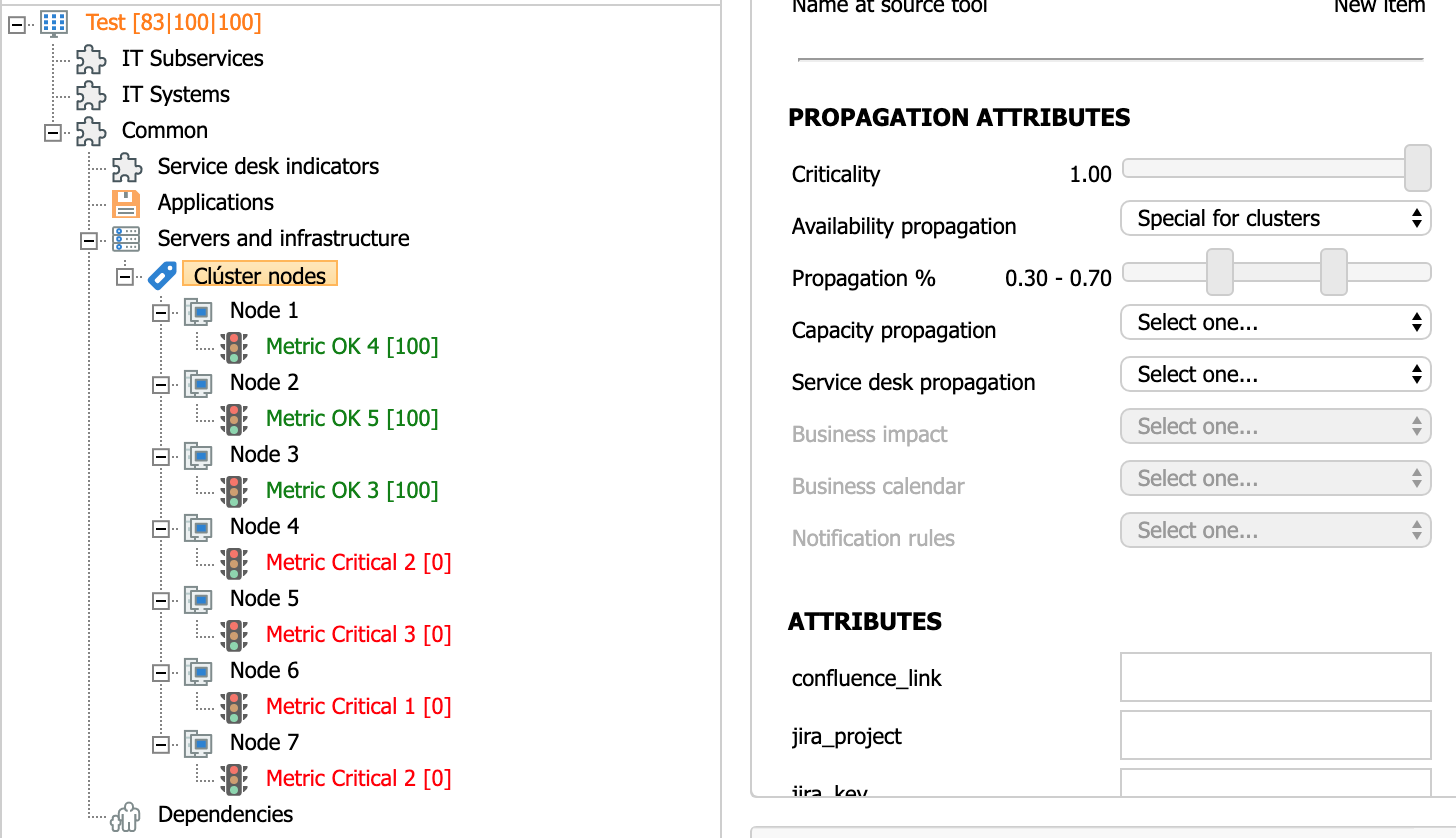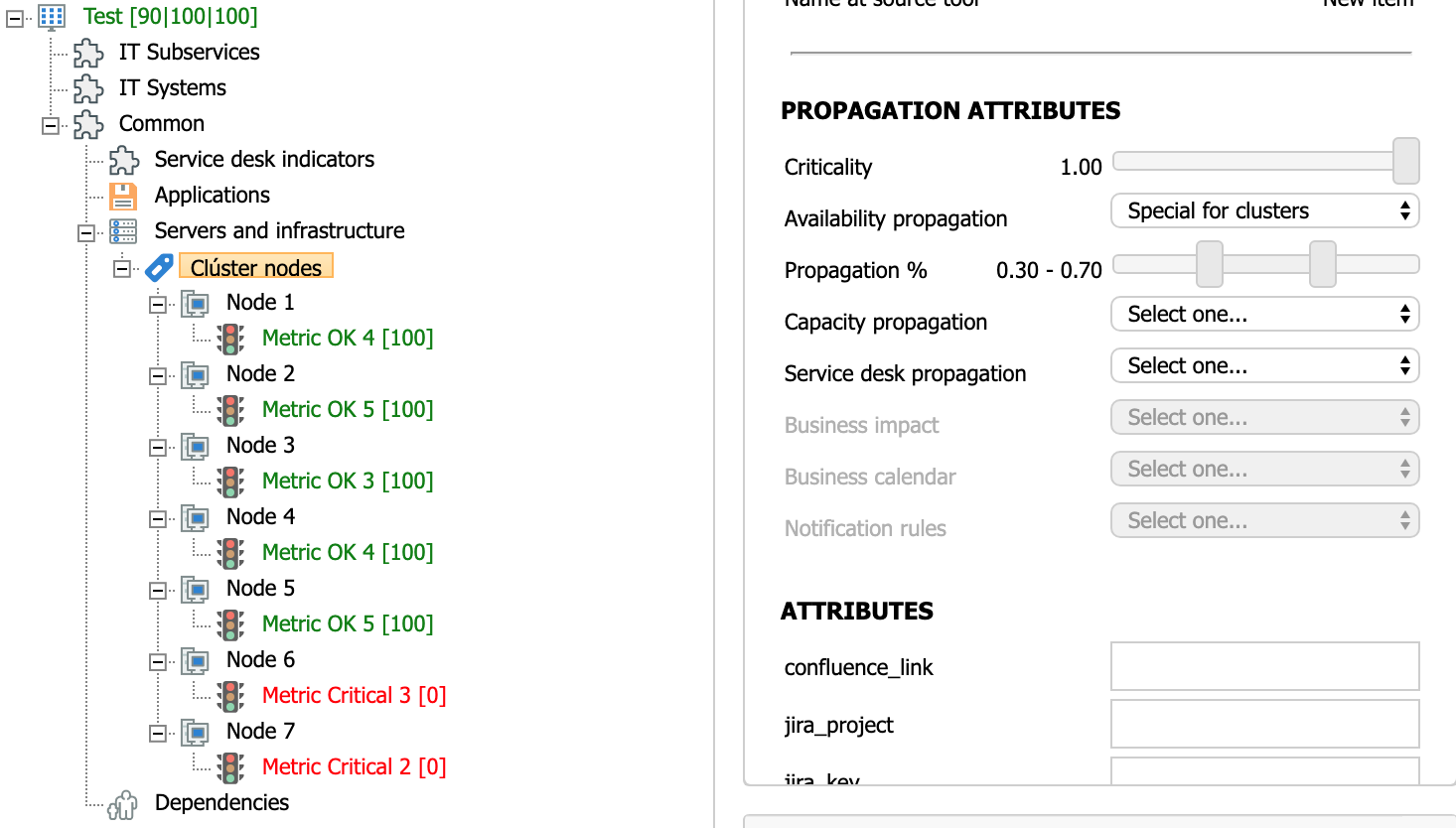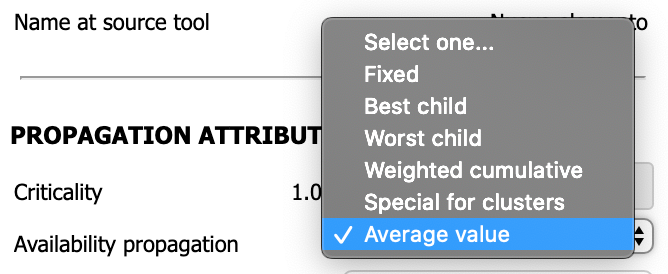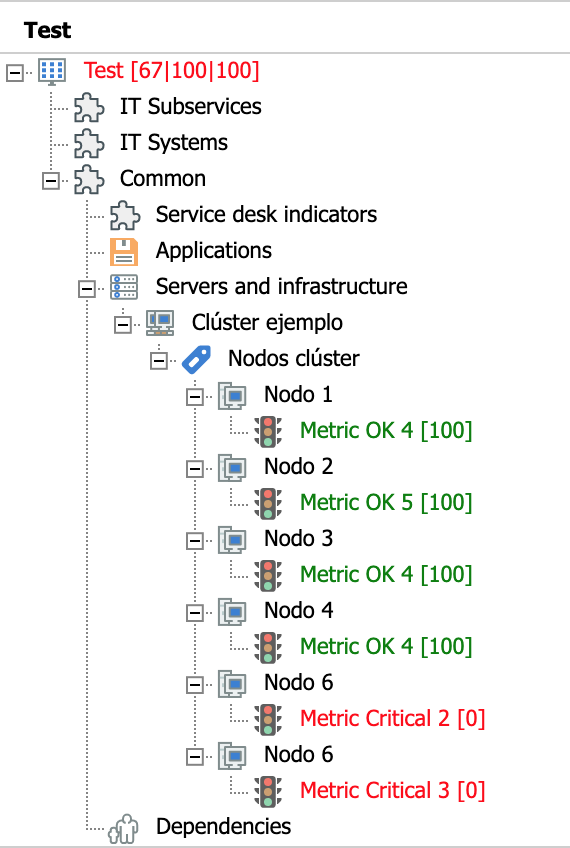Criterios de propagación
Introduction
In order to calculate each analysis dimension and obtain the level of service, Obsidian allows the definition of criticality and the configuration of different propagation criteria, aiming to adapt the calculation of each dimension to the characteristics of the service.
Below is an explanation of what these propagation criteria are and how the level of service is calculated in each case.
Criticality
Criticality is the degree of importance that a probe or an element has within the service. This parameter defines the extent to which the value of the probe will be propagated. So, a value of 0 will not propagate any value to the service, while a value of 1 will fully propagate the value.
The calculation of the value is carried out as follows:
EXAMPLE 1:
Let's say that the "Current load" capacity probe returns a value of 0. Since the criticality is 1, it will propagate the value of the probe in full:
Propagated value = 0 + (100 - 0) * (1 - 1) = 0 + 100 * 0 = 0
However, if its criticality is reduced to 0.25, the propagated value changes, affecting the service to a lesser extent:
Propagated value = 0 + (100 - 0) * (1 - 0.25) = 0 + 100 * 0.75 = 0 + 75 = 75
This way, when reducing the criticality to 0, the impact on the service is completely canceled. Regardless of the value returned by the probe, an OK (green) with a value of 100 will be propagated:
Propagated value = 0 + (100 - 0) * (1 - 0) = 0 + 100 = 100
EXAMPLE 2:
In this case, the availability probe "Check" (orange) returns a value of 85 with the criticality at 1:
However, when reducing its criticality to 0.05, the propagated value would be, according to the formula:
85 + (15 * 0.95) = 99.25 → 99
It should be noted that the probe in the first example is a capacity probe, while the second example corresponds to an availability probe. Each of these values are calculated separately to measure the state of the service. In Obsidian, it is possible to see the value of each dimension of the tree nodes, which are shown in [- | - | -] format. The first value corresponds to availability, the second to capacity and the third to service desk.
Propagation rules
While criticality weighs the impact of a given node on its parents, propagation rules weigh the value of a node's child nodes to define their impact on such node. Each parent node may have a different rule for propagating the values of each dimension (availability, capacity, and service desk).
Fixed
This rule propagates a fixed value (100), regardless of its child components. It is usually used for maintenance or specific interventions.
In the following example, there is a critical probe that returns a value of 0. However, when using the propagation rule "Fixed" on the "Dependencies" node, the service is not affected, and it displays an availability value of 100:
Best child
This rule propagates the value of the child node with the highest value. This option is useful for cases of an active-passive cluster, for example.
Below are two probes: one with a Warning (orange) value and the other with an OK (green) value. The value propagated to the service using the "Best child" rule is that of OK (100):
Worst child
This rule propagates the value of the child node with the lowest value. This is the default option for all nodes.
The following example shows two probes: one with a Warning (orange) value and the other with an OK (green) value. The value propagated to the service using the "Worst child" rule is that of Warning (85):
Weighted cumulative value
This rule propagates the weighted cumulative values of all probes. It is used for nodes composed of children with different criticality values. In contrast to the best and worst child rules, which focus only on the probe with the best and worst values respectively, this rule considers all the values of the probes to calculate the state of the service.
The following formula is used for calculating of the propagated value:
EXAMPLE:
Below is a test node that receives values from six different probes and propagates an availability value according to the "Weighted cumulative value" rule. Each probe returns a different value, and all values are taken into account when calculating the state of the service:
Propagated value = 100 - [(100-90) + (100-85) + (100-90) + (100-95) + (100-100) + (100-100)] = 100 - (10 + 15 + 10 + 5 + 0 + 0) = 100 - 40 = 60
Special for clusters
Operation with Obsidian 2
This rule allows you to weight the values of a set of child elements in percentages of Critical, Warning and OK. This is done as follows:
- When the special option for clusters is selected, a new field appears (% propagation):
- In order to complete this field, imagine the separation of sections as Critical → Warning → OK (in that order):
- The values of "% spread" will be assigned depending on the percentage of OK (green) child nodes required for each section. So, for this example:
- For 30% of OK child nodes or less, the return is a Critical value.
- If there are between 30% and 70% of OK child nodes, a Warning value is assigned.
- If there are more than 70% of OK child nodes, an OK value is obtained.
EXAMPLE:
Below is a service that has a cluster of 7 nodes. Assuming the propagation percentages above (0.30 and 0.70) it follows that:
- 0.3 * 7 = 2.1 → 2. If there are only 2 OK nodes or less (5 or more KO nodes), a Critical value is assigned.
- 0.7 * 7 = 4.9 → 4. If there are between 2 and 4 OK nodes (between 3 and 5 KO nodes), a Warning value is obtained.
- If there are more than 4 OK nodes (2 or less KO nodes), the service will have an overall availability value of OK.
Operation with Obsidian 3 calculation engine
In summary, the process involves interpolating between the percentage of child elements in each state and the threshold bar defined for the cluster. The final value obtained is proportional to how close or far the percentage is from the limits of the determined state. Below is a detailed explanation.
Determination of Final State and Value
The first step is to determine the final state, as the variables in the formula will take on different values depending on this state. Once the state has been decided, the corresponding value can be calculated.
Rules to Define the Final State
The state is determined based on the percentage of the cluster’s child elements in critical and warning states, along with the thresholds defined for the cluster:
If the percentage of criticals is higher than the right threshold, the state is Critical.
If the percentage of criticals is between the left threshold (exclusive) and the right threshold (inclusive), the state is Warning.
If the percentage of criticals is equal to or lower than the left threshold, the state is Ok.
If the percentage of warnings is higher than the right threshold, the state is Warning.
If the percentage of warnings is equal to or lower than the right threshold, the state is Ok.
Only elements in critical, warning or ok states count towards the total number of children. Elements in any other state are considered not to exist.
If several conditions are met simultaneously, the worst state will prevail.
If the same state can be reached through different paths, the lowest value will prevail.
Example of a cluster with 5 servers of which 2 are critical, 2 warning and 1 ok, and its configured cluster thresholds are 25 and 50:
Based on the criticals, the state should be Warning, since 40% is less than the right threshold but greater than the left.
Based on the warnings, the state should be Ok, since 40% is below the right threshold.
Since two paths are possible, we take the worst state, which is Warning.
Paths to determine the Final Value from an initial state percentage
Since the same final state can be reached through different evaluation paths, the following identifiers will be used in future explanations:
"c-c": Evaluating the percentage of criticals to determine if the state should be Critical.
"c-w": Evaluating the percentage of criticals to determine if the state should be Warning.
"c-o": Evaluating the percentage of criticals to determine if the state should be Ok.
"w-w": Evaluating the percentage of warnings to determine if the state should be Warning.
"w-oC": Evaluating the percentage of warnings to determine if the state should be Ok within the Central segment, that is, above the left threshold (but below the right, since the latter would be "w-w" path).
"w-oI": Evaluating the percentage of warnings to determine if the state should be Ok within the Left segment, that is, below the left threshold.
The upper markers represent the cases used to evaluate the percentage of warnings, while the lower markers correspond to the critical cases.
Value Calculation
Once the final state is determined, the value is calculated using the following formula:
Value = MV - (SR * CR / TR)
MV (Maximum Value of the State)
The maximum value associated with the final state. It depends only on the state being evaluated and aligns with the thresholds defined for the analyzed dimension.
Example (default Obsidian values for Capacity):
Critical state: 30
Warning state: 80
Ok state: 100
SR (State Range)
Represents the value range for the final state. It is obtained by subtracting the thresholds corresponding to that state.
Example (default Obsidian values for Capacity):
Critical state: critical - 0 = 30 − 0 = 30
Warning state: warning - critical = 80 − 30 = 50
Ok state: ok - warning = 100 − 80 = 20
CR (Cluster State Range)
This value varies depending on the path taken to reach the state, so, it depends on both the initial and final states being evaluated:
c-c:
percentageOfCriticalElements − rightThresholdc-w:
percentageOfCriticalElements − leftThresholdc-o:
percentageOfCriticalElements − 0w-w:
percentageOfWarningElements − rightThresholdw-oC:
percentageOfWarningElements − leftThresholdw-oI:
percentageOfWarningElements − 0
Example of a cluster with 5 critical servers out of 10 total, with thresholds 20 and 80: the path is "c-w", so, 50 - 20 = 30.
TR (Total Range of the Cluster State to Propagate)
Also depends on the chosen path:
c-c:
100 − rightThresholdc-w:
rightThreshold − leftThresholdc-o:
leftThreshold − 0w-w:
100 − rightThresholdw-oC:
rightThreshold − leftThresholdw-oI:
leftThreshold − 0
Example of a cluster with 5 critical servers out of 10 total, with thresholds 20 and 80: the path is "c-w", so, 80 - 40 = 40.
Calculation Examples
For all examples, an identifying name is provided along with the path used to calculate the value and the percentage of elements in critical, warning, and ok states. Additionally, the examples are grouped based on the thresholds configured in the clusters. The thresholds for the dimension being calculated are ok=100, warning=80 and critical=30. In some cases, all possible paths are listed, from which the lowest resulting value should be selected as the final value.
Example Group 1
This group illustrates how the final value changes as the percentage of elements in each state increases.
Example Group 2
This group of examples covers all possible combinations for each state, that is, for each percentage of ok, warning, and critical, matching the left, central, and right segments.
Critical
Warning
OK
Average value
This rule allows the propagation of the average value of a set of child elements.
The following example shows a cluster with six nodes: two with a Critical value of 0 and four with an OK value of 100. The set-type node "Cluster nodes" has been assigned the propagation rule "Average value", so the value of the service is the average of all the values of its child nodes (in this case, 67):






